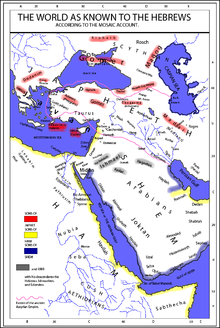Madai
This articleneeds additional citations forverification.(October 2021) |

Madai(Hebrew:מָדַי,pronounced[maˈdaj];Greek:Μηδος,[mɛːˈdos]) is a son ofJaphethand one of the 16 grandsons ofNoahin theBook of Genesisof theHebrew Bible.
Associated nations
[edit]Medes and related Iranian nations
[edit]Biblical scholars have generally identified Madai with the IranianMedesof much later records. The Medes, reckoned to be his offspring byJosephusand most subsequent writers, were also known asMadai,including in bothAssyrianandHebrewsources.[citation needed]
Also linked with Madai is theIraniancity ofHamadan.[citation needed]
TheKurdsandBalochsstill maintain traditions of descent from Madai.[1]
Others
[edit]Some scholars in more modern times have also proposed connections with various earlier nations, such asMitanni,[2]Matiene,andMannai.
In the Book of Jubilees
[edit]According to theBook of Jubilees(10:35-36), Madai had married a daughter ofShem,and preferred to live among Shem's descendants, rather than dwell in his allotted inheritance beyond theBlack Sea(seemingly corresponding to theBritish Isles),[3]so he begged his brothers-in-law,Elam,AsshurandArphaxad,until he finally received from them the land that was named after him, Media.
Another line inJubilees(8:5) states that a daughter of Madai named Milcah (Aramaic:Melkâ) marriedCainan,who is an ancestor ofAbrahamalso mentioned in theSeptuagintversion of Genesis and in theGospel of Luke(3:36).
Purported link with Medos and Medea
[edit]Medos(Μηδος), and his motherMedea,were also reckoned to be the ancestors of the Medes in classical Greek mythical history. Christian scholars have proposed linking HebrewMadaiand GreekMedossince at least the time ofIsidore of Seville[Etym9.2.28], ca. 600 AD.[citation needed]
References
[edit]- ^Mahir A. Aziz, 2011,The Kurds of Iraq: Ethnonationalism and National Identity in Iraqi Kurdistan,p. 47.
- ^Emmet John Sweeny,Empire of Thebes, Or Ages in Chaos Revisited,2006, p. 11.
- ^Machiela, Daniel (23 October 2009).The Dead Sea Genesis Apocryphon: A New Text and Translation with Introduction and Special Treatment of Columns 13-17.ISBN9789047443018.
